Monthly Archive: March 2014
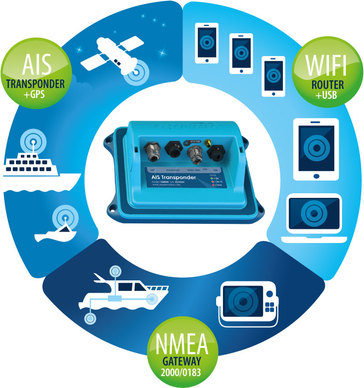 I’ve had a Vesper XB-8000 installed in the lab for the last month, and am confident that it will do well in a long test on board Gizmo beginning in May. I will miss some features of the Vesper Vision I tested last season, but having the blue box installed behind the scenes will help me test the glass bridge concept (one MFD brand, many screens), and at $799 I think the XB-8000 is a multifunction value that could work on a wide variety of vessels. The recent testing also revealed some new features that apply to both the XB and the Vision as Vesper continues to expand on the concepts expressed in the 3-in-1 diagram above…
I’ve had a Vesper XB-8000 installed in the lab for the last month, and am confident that it will do well in a long test on board Gizmo beginning in May. I will miss some features of the Vesper Vision I tested last season, but having the blue box installed behind the scenes will help me test the glass bridge concept (one MFD brand, many screens), and at $799 I think the XB-8000 is a multifunction value that could work on a wide variety of vessels. The recent testing also revealed some new features that apply to both the XB and the Vision as Vesper continues to expand on the concepts expressed in the 3-in-1 diagram above…
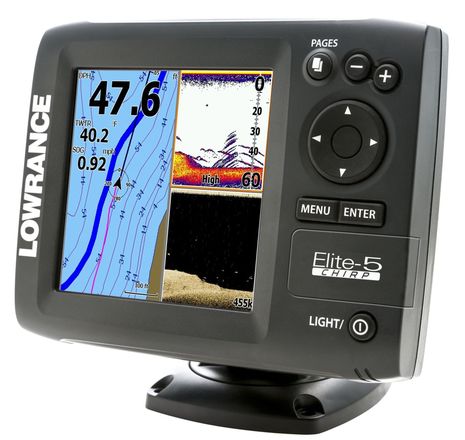 Lowrance just launched Elite-5 and -7 CHIRP fishfinders and plotter combos today, but they showed off working prototypes during the Navico writer’s event I attended in January. What seemed to particularly excite the product managers was the Elite’s new ability “to produce low, medium and high CHIRP sonar ranges and display two user-selected ranges simultaneously” using just an “affordable” HDI Skimmer transducer. Apparently they didn’t realize that this tranducer could usefully CHIRP until they tried it, and now they think they have a edge in the sonar battle that’s taking place both on the water and in law offices…
Lowrance just launched Elite-5 and -7 CHIRP fishfinders and plotter combos today, but they showed off working prototypes during the Navico writer’s event I attended in January. What seemed to particularly excite the product managers was the Elite’s new ability “to produce low, medium and high CHIRP sonar ranges and display two user-selected ranges simultaneously” using just an “affordable” HDI Skimmer transducer. Apparently they didn’t realize that this tranducer could usefully CHIRP until they tried it, and now they think they have a edge in the sonar battle that’s taking place both on the water and in law offices…
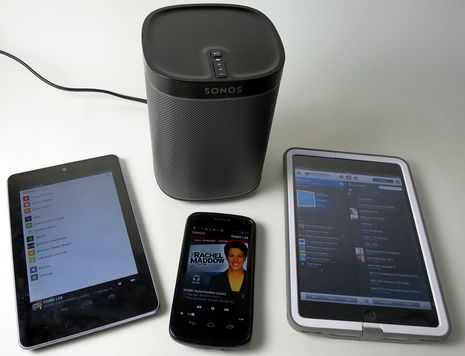 I knew little about Sonos wireless hifi a month ago. While the ads suggested an elegant Apple-like design, I had the impression it also came with Apple-like premium prices and was certainly not suitable for boats. But now that I’ve lived for a month with the relatively new Play:1 seen above, I may have been wrong on both counts! Many reviewers have already praised the little speaker/amp’s hardware and audio quality compared to similar wireless speakers. I want to detail the superb Sonos audio access and control software that you can tap into with just one $199 Play:1(though adding more components will be a huge temptation) and also discuss how Sonos can make sense afloat.
I knew little about Sonos wireless hifi a month ago. While the ads suggested an elegant Apple-like design, I had the impression it also came with Apple-like premium prices and was certainly not suitable for boats. But now that I’ve lived for a month with the relatively new Play:1 seen above, I may have been wrong on both counts! Many reviewers have already praised the little speaker/amp’s hardware and audio quality compared to similar wireless speakers. I want to detail the superb Sonos audio access and control software that you can tap into with just one $199 Play:1(though adding more components will be a huge temptation) and also discuss how Sonos can make sense afloat.
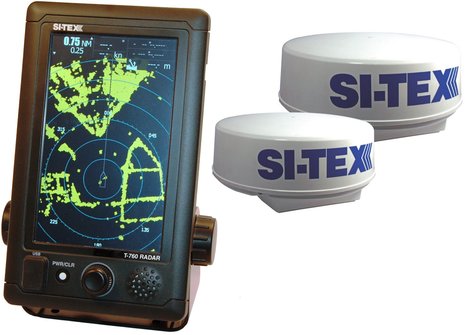 There’s more to the new Si-Tex T-760 Series radar than you’ll currently find on that product page. Those multi-speed radomes are unlike anything Si-Tex has offered before and contain digital processing that will eventually put 16-level true color target imagery on that 800 x 480 pixel touch screen (with a software update). Plus the case is carved from solid aluminum and can be easily flush mounted. At a suggested retail of about $2,100 with the 18-inch radome and an impressive set of radar features, the T-760 looks like an interesting alternative for boaters who don’t want all their electronic navigation tools on a multifunction display. It might also work for those early adopters who can’t get radar on the tablets they want to use for primary navigation…
There’s more to the new Si-Tex T-760 Series radar than you’ll currently find on that product page. Those multi-speed radomes are unlike anything Si-Tex has offered before and contain digital processing that will eventually put 16-level true color target imagery on that 800 x 480 pixel touch screen (with a software update). Plus the case is carved from solid aluminum and can be easily flush mounted. At a suggested retail of about $2,100 with the 18-inch radome and an impressive set of radar features, the T-760 looks like an interesting alternative for boaters who don’t want all their electronic navigation tools on a multifunction display. It might also work for those early adopters who can’t get radar on the tablets they want to use for primary navigation…
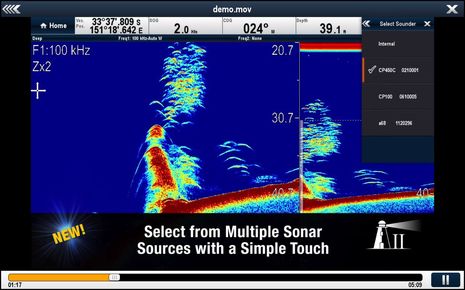
One of many features in Raymarine’s latest software update (besides the just-discussed LightHouse charts) is support for multiple sonar sources. While I didn’t have the hardware or even the working vessel to test this, it’s neat that the demo video I screenshot above is built right into the LightHouse II update (and actually more detailed than the one currently on YouTube). But who needs multiple sonar sources? I know that some readers may perceive it as feature glut, but not I, and I’m not even much of a fisherman…
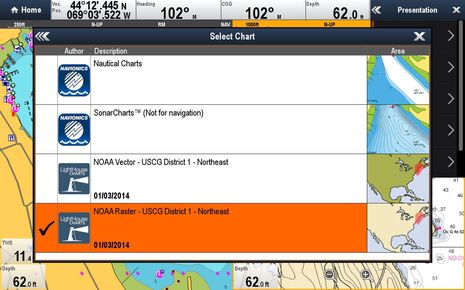
A demo look at the new LightHouse Charts got me excited last fall and I feel more so now that I’ve cruised around with them. U.S. boaters who own Raymarine a-, c-, e-, or gS-Series multifunction displays will find that both types of reprocessed free NOAA charts install fairly easily, look good, and zoom/pan quickly. And though no LightHouse charts for waters beyond the U.S. have been announced, Raymarine clearly has the ability to produce them or permit third party cartographers like NV-Chart to do it themselves. Finally, Raymarine’s U.S. plotter models should hopefully cost a little less with free charts and Navionics has perhaps been motivated to up its game. (Whatever the motivation, significant new Navionics features are right around the corner.)

These days I feel obliged to include a warning every time I write about AIS over the Internet. What you see in a nice app like ShipFinder HD (above) probably does not include every vessel that’s transmitting AIS info even in fairly well covered areas like the Miami/Lauderdale area, and many areas aren’t covered at all…unless perhaps you’re using the Seapilot app in Sweden or somehow have access to another well-organized AIS receiver system. That’s because what most of us see on computers, phones or tablets connected to the Web is target data collected by patchy networks of volunteers whose shore antennas may well miss even fairly nearby 2 Watt Class B AIS transmissions or even 12 Watt Class A signals obscured by buildings or terrain (or may suddenly go offline just because the volunteer’s kid trips on a power cord or similar).
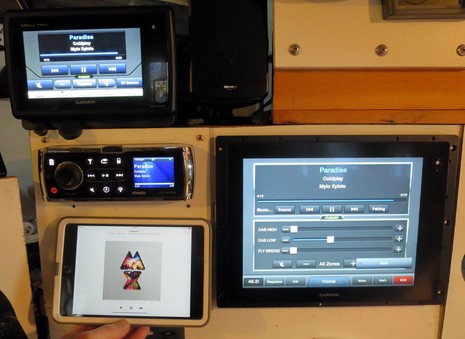
The ability of Fusion marine stereo systems to integrate with multifunction displays over NMEA 2000 (or Ethernet) is a wonderful example of what MFDs and standard network protocols can do for us. One day last summer a Garmin software update suddenly made the GPSMap 7212 already installed on Gizmo’s fly bridge the best interface I had for the Fusion IP700 stereo installed below. And, mind you, I already a Fusion NRX remote control up there and also had the Fusion Remote apps running on iPad and smartphone via Gizmo’s WiFi router. There was a notable glitch, which I’ll describe, but that’s long past and now Fusion-Link has arrived beautifully in the Garmin 740 and 8000 Series MFDs seen above.
 I’ve had a Vesper XB-8000 installed in the lab for the last month, and am confident that it will do well in a long test on board Gizmo beginning in May. I will miss some features of the Vesper Vision I tested last season, but having the blue box installed behind the scenes will help me test the glass bridge concept (one MFD brand, many screens), and at $799 I think the XB-8000 is a multifunction value that could work on a wide variety of vessels. The recent testing also revealed some new features that apply to both the XB and the Vision as Vesper continues to expand on the concepts expressed in the 3-in-1 diagram above…
I’ve had a Vesper XB-8000 installed in the lab for the last month, and am confident that it will do well in a long test on board Gizmo beginning in May. I will miss some features of the Vesper Vision I tested last season, but having the blue box installed behind the scenes will help me test the glass bridge concept (one MFD brand, many screens), and at $799 I think the XB-8000 is a multifunction value that could work on a wide variety of vessels. The recent testing also revealed some new features that apply to both the XB and the Vision as Vesper continues to expand on the concepts expressed in the 3-in-1 diagram above…














